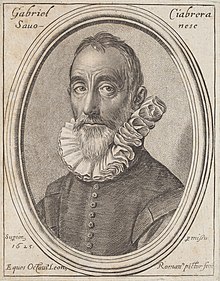Gabriello Chiabrera
Gabriello Chiabrera | |
|---|---|
 Ottavio Leoni, Gabriello Chiabrera, 1625, engraving and stipple in laid paper, Washington, National Gallery of Art | |
| Born | 18 June 1552 Savona, Republic of Genoa |
| Died | 14 October 1638 (aged 86) Savona, Republic of Genoa |
| Occupation | Poet |
| Language | Italian |
| Nationality | Italian |
| Period | Late Middle Ages |
| Literary movement | Baroque |
| Notable works | Canzonette Il rapimento di Cefalo Orfeo dolente |
| Spouse | Lelia Pavese |
Gabriello Chiabrera (Italian pronunciation: [ɡabriˈɛllo kjaˈbrɛːra]; 18 June 1552 – 14 October 1638) was an Italian poet, sometimes called the Italian Pindar.[1] His "new metres and a Hellenic style enlarged the range of lyric forms available to later Italian poets."[2]
Biography
Chiabrera was of
Losing his uncle about this time, Chiabrera returned to Savona, "again to see his own and be seen by them." A little while later he returned to Rome and entered the household of a
Poets of his choice were Pindar and
Works

A maker of odes in their elaborate pomp of
Giambattista Marino was a contemporary of Chiabrera whose verses provide a comparison.[4]
References
- ^ a b c d e One or more of the preceding sentences incorporates text from a publication now in the public domain: Chisholm, Hugh, ed. (1911). "Chiabrera, Gabriello". Encyclopædia Britannica. Vol. 6 (11th ed.). Cambridge University Press. p. 117. Endnote: The best editions of Chiabrera are those of Rome (1718, 3 vols. 8vo); of Venice (1731, 4 vols. 8vo); of Leghorn (1781, 5 vols., 12mo); and of Milan (1807, 3 vols. 8vo). These only contain his lyric work; all the rest he wrote has been long forgotten.
- ^ Jarndyce Catalogue No. CCLI, London, Autumn 2021, Item 134.
- ^ Siste Hospes./Gabrielem Chiabreram vides;/Thebanos modos fidibus Hetruscis/adaptare primus docuit:/Cycnum Dircaeum/Audacibus, sed non deciduis pennis sequutus/Ligustico Mari/Nomen aeternum dedit:/Metas, quas Vetustas Ingeniis/circumscripserat,/Magni Concivis aemulus ausus transilire,/Novos Orbes Poeticos invenit./Principibus charus/Gloria, quae sera post cineres venit,/Vivens frui potuit./Nihil enim aeque amorem conciliat/quam summae virtuti/juncta summa modestia.
- ISBN 9780807837733. Retrieved 2016-07-31.
![]() This article incorporates text from a publication now in the public domain: Herbermann, Charles, ed. (1913). "Gabriello Chiabrera". Catholic Encyclopedia. New York: Robert Appleton Company.
This article incorporates text from a publication now in the public domain: Herbermann, Charles, ed. (1913). "Gabriello Chiabrera". Catholic Encyclopedia. New York: Robert Appleton Company.
External links
- Rossi, P. (2002). "Chiabrera, Gabriello". The Oxford Companion to Italian Literature. Oxford University Press. Retrieved 7 June 2023.
- Works by Gabriello Chiabrera at Project Gutenberg
- Works by or about Gabriello Chiabrera at Internet Archive
- Gabriello Chiabrera entry (in Italian) in the Enciclopedia italiana, 1931
- Merola, Nicola (1980). "CHIABRERA, Gabriello". ISBN 978-8-81200032-6.
- ISBN 9780198020066.
- Giordano, Paolo A. (2006). Gaetana Marrone; Paolo Puppa (eds.). "Gabriello Chiabrera". Encyclopedia of Italian Literary Studies. ISBN 9781135455309.
